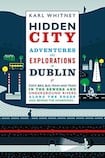
Psychogeography is an approach to urban spaces that encourages strategies – often playful – to take us away from our usual paths and routines and create in us a new awareness of our environments.
The roots of psychogeography lie in Dadaism, Surrealism and the practice of the flâneur. Guy Debord, the French theorist and founding member of the Paris-based avant-garde group the Situationists, defined it in a 1955 essay as a "study of the precise laws and specific effects of the geographical environment, consciously organised or not, on the emotions and behaviour of individuals". Psychogeography is also the guiding spirit behind Hidden City, the first book by Karl Whitney.
Whitney was born in Tallaght in 1978, when the area was “a melting pot of working-class Dubliners, middle-class families in starter homes and peripatetic Travellers”. He was reared there and in Ballyboden, and he has interesting things to say about the growth of suburbs and estates. A journalist with a doctorate in history, Whitney is now a research associate at the Humanities Institute at UCD. He brings to his project a journalistic eye and a sense of whimsy.
Dublin, he writes, is a collection of barely connected fragments of urban, suburban and rural: “edgeland housing adjoining lonely link roads, smashed glass in supermarket car parks, the trickle of a pungent river as it passes through a concrete pipe below a dual carriageway . . . a city defined more by its margins than by its centre, and more by its hidden places than by its obvious landmarks”.
Whitney goes underground, to the tunnels through which the Poddle flows before emptying into the Liffey.
He follows, on foot, the flight path of jets arriving into Dublin airport. He explores Poolbeg, “where the necessary functions of the city . . . go to hide”, but which is, in its “separate, raw, unfinished, provisional” way, just a “slightly distorted mirror image of the city as a whole”.
He goes into horribly fascinating detail about sewage treatment in Dublin. Readers will be interested to know that biofert – dried fertiliser produced from sewage sludge in Ringsend – is still sold to farmers here, although it’s banned by a number of Ireland’s leading food organisations.
Much of Hidden City concerns itself with Dublin's growth over the past decades and the question of whether the new suburbs are any more conducive to happiness than the ones in which Whitney grew up. He looks at the bad planning, political corruption and careless regulatory environment of the boom years, and the resulting eyesores and public health hazards.
He does a case study of Adamstown, a development that was, in part, an effort to create a blueprint guided more by public interest than by developers. Adamstown, south of Lucan, was just getting under way when the bottom fell out of the market. Only a fraction of its planned 10,000 units have been built.
“The yawning vastness of the void – the sheer volume of negative space left by the undeveloped stretches of waste ground – dwarfed the inhabited sections of the site, making the houses feel huddled together on the frontier of a dark and impenetrable wilderness.”
Whitney also travels to Tyrrelstown, to where 15-year-old Nigerian Toyosi Shitta-Bey was stabbed to death in 2010, to explore the state of immigrant integration. This story and others in Hidden City – Sean Dunne's wrangles in Ballsbridge; the Dublin Docklands Development Authority and the Glass Bottle Site; Priory Hall and Thomas McFeely, the former IRA hunger striker turned property developer – have been well documented. But when these stories begin to fade in the collective memory, the book will offer a mosaic that tells us something about how Dublin came to look and feel the way it does.
The quirkier pieces include Whitney playing a game on Dublin Bus, in which he buys a 90-minute ticket and boards and disembarks according to a random but highly structured set of rules. Elsewhere, he follows the Liffey downstream from Heuston Station, on foot, crossing its 16 accessible bridges as he goes.
I found the Liffey chapter strangely moving, perhaps because of my own blissful journeys up the quays, but also because of the tenderness with which Whitney regards this “murky, tidal, polluted river”.
The book's prevailing tone, in fact, is one of tenderness. Years ago I read an essay by Harry Clifton on Eliot. Clifton's account of the difference between infatuation and love came back to me while reading Hidden City: love, unlike infatuation, cultivates an ironic distance on who, or what, is loved, without ceasing to love it.
Visitors to Dublin often become, to the confoundment of locals, infatuated with the city, somehow blind to its grottiness, its roughness, and that “unfinished, provisional” quality.
Whitney is clear-eyed and critical, but never cynical or ungenerous, and he has produced an idiosyncratic and surprisingly nostalgic homage to a sometimes filthy, always flawed, deeply lovable city.












